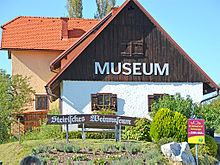Styrian wine routes

Under the term Styrian Wine Roads , eight wine roads were officially established by the “Styrian Wine” market community. More than 2000 winegrowers have settled on these wine routes and thus most of the wineries in the three wine-growing regions of Southern Styria, Western Styria and Vulkanland are located. There are many wine taverns along these wine routes that offer regional specialties and wines. Wine connoisseurs and tourists can get to know the most important wine-growing communities with their diversity of landscapes and viewpoints.
The eight wine routes
- The South Styrian Wine Road (wine-growing region South Styria )
- The Klapotetz wine route (wine-growing region of southern Styria)
- The Sausal Wine Route (wine-growing region South Styria)
- The Schilcher Wine Road (wine-growing region West Styria )
- The Southeast Styrian Hügelland Wine Road (wine-growing region Vulkanland Styria )
- The East Styrian Roman Wine Route (wine-growing region Vulkanland Styria)
- The Thermenland Wine Route (wine-growing region Vulkanland Styria)
- The Klöcher Weinstrasse (wine-growing region Vulkanland Styria)
- The name for the wine-growing region "Vulkanland Steiermark" was until 2015: "Süd-Oststeiermark"
The South Styrian Wine Route
The oldest and most famous is the South Styrian Wine Route . Since 1956, it has been an adventure route from Spielfeld and Ehrenhausen via Ratsch and Gamlitz to Leutschach . The wine route runs right through the wine-growing region of the Styrian Windische Büheln , south of Ehrenhausen, branches off to the southwest at the Platschberg , along the Austrian - Slovenian state border, partly on the border line and a few meters even on Slovenian territory (two road sections with a total length of 2.5 km the state border). Several vertices offer wonderful views, there are many excursion destinations in the area, e.g. B .:
- the Kreuzbergwarte
- the Schlossbergwarte in Schloßberg
- the Lafarge Perlmooser cement works in Retznei
- the Archduke Johann Barracks Museum of Troops in Straß
- the castle playing field in playing field
- the Attemsmoor
- the Altenbachklamm in Oberhaag
- the Heiligengeistklamm ("Most beautiful place in Styria")
- the Urbani Chapel in Ratsch an der Weinstrasse
- the largest grape in the world on the Eorykogel
- the border table ( Slovenian Miza na Meji ) on the state border at Glanz on the Wine Route
- the world's largest Klapotetz in Schloßberg
The Klapotetz Wine Route
The second is the Klapotetz wine route between the South Styrian and Sausal wine routes. It was originally called the Rebenland Wine Route , but was renamed due to the numerous Klapo nets along the way. It leads from Arnfels via Eichberg-Trautenburg and Glanz an der Weinstrasse to Langegg.
The Sausal Wine Route
The third is the Sausal Wine Route , which begins in Leibnitz and first leads through the Sulmtal to Fresing. From there the road runs steeply uphill to Kitzeck , the highest wine-growing town in Europe, and then continues through the Sausal hill country to Maierhof in the Sulmtal .
The well-known technical college for agriculture and forestry Silberberg is located between Leibnitz and Heimschuh , which is dedicated not only to research but also to the training of fruit and wine growers. The Silberberg winery now belongs to the Silberberg wine school founded in 1895.
The Schilcher Wine Route
The fourth is the Schilcher Wine Route , it begins in Ligist and leads via Gundersdorf and Greisdorf to Stainz . From there it continues via Bad Gams , Deutschlandsberg and Hollenegg to Eibiswald . The street signs contain a white horse, the logo of the Schilcherschutzverein.
Worth seeing are u. a .:
- "Stainzer Flascherlzug"
- Schilcherdorf Wernersdorf
- Schilcherland Stainz - Reinischkogel
- Hochgrail vineyards, winner of 9 places 9 treasures 2019
The Southeast Styrian Hill Country Wine Route
The fifth is the Southeast Styrian Hügelland Wine Road , it begins on the Klöcher Wine Road in Frutten-Gießelsdorf and leads via Straden to Sankt Peter am Ottersbach .
The East Styrian Roman Wine Route

The sixth is the East Styrian Roman Wine Route , it begins in Gleisdorf and leads via Siegersdorf bei Herberstein , Sankt Johann bei Herberstein , Hartberg and Sankt Magdalena am Lemberg to Bad Waltersdorf .
The Herberstein Castle and the Herberstein animal world are particularly worth seeing .
The Thermenland Wine Route
The seventh is the Thermenland Weinstrasse , it begins in Fehring as a continuation of the Klöcher Weinstrasse and leads back to Fehring via Unterlamm , Übersbach , Großwilfersdorf , Markt Hartmannsdorf and Riegersburg .
The Riegersburg castle complex is particularly worth seeing .
The Klöcher Wine Route
The eighth is the Klöcher Wine Route , it begins in Bad Radkersburg and leads north via Klöch , Pichla bei Radkersburg , Frutten-Gießelsdorf , Sankt Anna am Aigen and Kapfenstein to Fehring .
Worth seeing are in the area u. a .:
- Kapfenstein Castle
- The entire Styrian vinotheque in St. Anna am Aigen
- Klöch Wine Museum
See also
Web links
- South Styrian Wine Route
- Styrian wine roads with routes
- Schilcherdorf Wernersdorf
- Schilcherland Stainz-Reinischkogel
References and comments
- ^ Wine routes. Wein Steiermark, accessed on August 20, 2018 .
- ↑ wine school Silberberg silberberg.at





